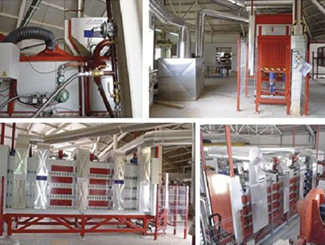 by Alberto Barbieri28
Novembre
2013
by Alberto Barbieri28
Novembre
2013
A laser kiln for firing ceramics
The use of laser technology allows for a lower firing temperature and potential for innovative aesthetic effects
The first prototype of a laser kiln for firing structural ceramics, developed as part of the European Laserfiring project, was presented in Toledo, Spain on 30 July this year.
The Spanish National Research Council (CSIC), in collaboration with researchers from the Institute of Materials Science of the University of Zaragoza and the companies Easy Laser and Physic GM (the laser and kiln manufacturers, respectively), developed a new method for firing structural ceramics based on laser technology with the aim of reducing greenhouse gas emissions.
“The ceramic industry uses very high firing temperatures, up to 1200°C. This results in high energy consumption and the emission of large quantities of greenhouse gases such as CO2 deriving from the energy sources,” explained the project leader, Professor Xermán De La Fuente from the University of Zaragoza.
The use of laser technology during the firing stage allows for a 100°C to 300°C reduction in process temperature without affecting the structural properties of the fired materials. Lowering the firing temperature from 1,100°C to 800°C brings savings in gas consumption per ton of finished product of between 23% and 50%. In a medium sized plant with a production capacity of 300 tones a day, this corresponds to a reduction in atmospheric CO2 emissions of between 3,563 and 7,750 tons per year.
In addition to the Laserfiring project for structural ceramics, which received more than 2.4 million euros of funding, about half of which has come from the European LIFE+ programme for research into eco-sustainable production techniques, a further project called Ceramglass to build the first prototype of a laser kiln for ceramic tiles is also nearing completion. Likewise part of the LIFE+ programme, it has received 2.9 million euros worth of funding and is coordinated by CSIC with Torrecid as the industrial partner. The goal of the project is to apply technology previously developed for the structural ceramic prototype to ceramic tiles, third fired tiles and glass tiles. The Ceramglass project involves the construction of a plant combining an electric kiln equipped with 13m rollers with a 2.2 kW laser, the first prototype of which is due to be unveiled in January 2014. CSIC is the owner of the international patent WO/2007/101900.
One advantage of laser technology is that it can reach much higher temperatures on the surface of materials than is possible in a conventional kiln while maintaining the temperature in the substrate at between 500°C and 1200°C, thus avoiding deformation or breakages. In the single firing process, the highest temperature that can be reached in a conventional kiln is 1140°C whereas the laser kiln can achieve a temperature on the tile surface of more than 2000°C without damaging the substrate. As glaze development was previously limited by the temperatures that could be withstood by the substrate, it is now possible to obtain decorations and/or surfaces with superior mechanical properties.
As De La Fuente notes, “The prototype of a laser kiln for ceramic tiles still has some technical limitations concerning the applicable sizes (maximum width of 60 cm), maximum production speed (36 m/h), kiln temperature (still no higher than 1200°C) and maximum laser power (2.2 kW).” However, the Ceramglass prototype can be used to develop scalable systems for conventional industrial kilns fitted with a laser module. Current kilns would continue to operate without changes and the laser module would be used only when required by the material.
The intention of Physic GM is to produce a Laser-kiln module – the costs of which are still to be evaluated – to be introduced onto conventional kilns without altering their functionality. This way the use of a laser kiln would be compatible with any conventional industrial process and could be used only to produce special pieces or to adapt conventional technology to achieve more efficient production of ceramic tiles.
The technology used for both projects is produced by the company Rofin in Germany and consists of a SLAB type CO2 laser with an emission power of up to 8 kW. The laser currently in use in the Ceramglass project has a power of 2.2 kW, whereas for the Laserfiring prototype two 400 W lasers were used, installed in opposite positions so as to be able to treat the 4 sides of the product.
De La Fuente believes that the laser kiln is not just a major innovation but in many ways is actually highly revolutionary. The innovative nature of the project will very soon be clear, he explains. “By applying the laser technology to already familiar materials we will be able to produce a wide variety of finishes with the same or superior optical and mechanical properties to what is possible at present.” The potentially revolutionary aspect is part of a more long-term scenario in which the development of an extremely high-temperature surface chemistry would allow for previously unimaginable chemical, mechanical and optical characteristics. “The reason we are so optimistic is that this is the first time we have developed an industrial technique that allows us to reach extremely high temperatures and maintain constant control of the texture and microstructure of the coating and material surface while ensuring competitive levels of productivity,” concluded Professor De La Fuente.